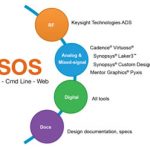In my initial look at ClioSoft’s design management system created from the ground up for the semiconductor industry, I made the opening case for managing and reusing IP across an ASIC design organization. Let’s for a moment say we agree on the need for an enterprise software package to do design management… Read More
Tag: open source
Fit-for-purpose IoT ASICs are about more than cost
We’ve been saying for a while that it looks like there is a resurgence in design starts for ASICs targeting the IoT. A recent webinar featuring speakers from ARM and Open Silicon (and moderated by Daniel Nenni) affirms this trend, and provides some insight on how these designs may differ from typical microcontrollers.
One of my first… Read More
Managing and Reusing IP in a Build-Borrow-Buy Era
Make-versus-buy inadequately describes what we do now in electronic systems design. We are on a continuum of design IP acquisition and use decisions, often with a portfolio of active projects and future projects depending on the outcome. Properly managing IP means adopting a build-borrow-buy mindset and tools capable of handling… Read More
OCF shows there may be hope for IoT consortia yet
The recent launch of the Open Connectivity Foundation (OCF) was met first with a wave of “oh good, another IoT consortium”, then “phew, it’s just a rebrand of the OIC”, followed by a bit of confusion over why a few AllSeen Alliance players and some other names jumped in. Is it just a marketing ploy, or is there more to this?… Read More
Chips on the road to deep learning
CES has been morphing into an automotive show for several years now. Chipmakers were pitching control solutions, infotainment solutions, then connectivity solutions. Phone makers pitched device integration. Automotive electronics suppliers pitched MEMS sensors and cameras. Now, with a lot of pieces in place, the story … Read More
mbed OS abstraction battles IoT hyperfragmentation
In the days of bit banging and single-threaded loops, programming a microcontroller meant grabbing a C compiler (or even before that, an assembler) and some libraries and writing bare metal code. High performance networking and multi-tasking was usually the purview of heavier real-time operating systems (RTOS) or, if an MMU… Read More
embARC for a Free Ride
It’s probably the first time that Synopsys is offering such a direct access to free and open source software. The goal is to support customers developing application code for IoT and embedded devices based on ARC IP core family. The designer can select the Real Time Operating System (RTOS) which best meet the system requirements,… Read More
Vlang – Opportunities Galore for Productivity & Performance
Yes, verification technologies are open to innovation for improved productivity and performance in the face of ever growing SoC/IP design sizes and complexities. There is not much scope left in processor speed to improve, other than multi-core processors in servers which again need software properly architected to be thread-able… Read More
Open Source Verilog
Over the years there have been various open source EDA projects but none that has realized a full industrial strength design tool that has broad adoption and is strong enough to compete with similar products from the EDA industry.
Open source is clearly a great way to develop software. Lots of people can see all the source code and … Read More
Then, Python walked in for verification
Go ahead – type “open source” into the SemiWiki search box. Lots of recent articles on the IoT, not so many on EDA tools. Change takes a while. It has only been about five years since the Big Three plus Aldec sat down at the same table to work on UVM. Since then, Aldec has also gotten behind OS-VVM, and is now linked to a relatively new open… Read More





